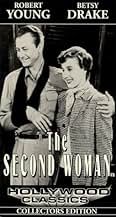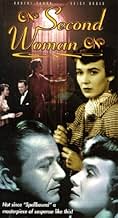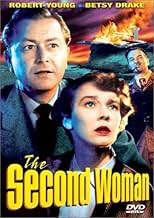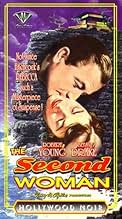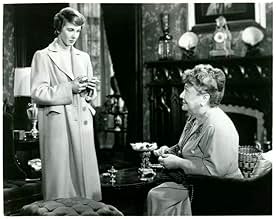VALUTAZIONE IMDb
6,3/10
1505
LA TUA VALUTAZIONE
Aggiungi una trama nella tua linguaIn flashback from a 'Rebecca'-style beginning: Ellen Foster, visiting her aunt on the California coast, meets neighbor Jeff Cohalan and his ultramodern clifftop house.In flashback from a 'Rebecca'-style beginning: Ellen Foster, visiting her aunt on the California coast, meets neighbor Jeff Cohalan and his ultramodern clifftop house.In flashback from a 'Rebecca'-style beginning: Ellen Foster, visiting her aunt on the California coast, meets neighbor Jeff Cohalan and his ultramodern clifftop house.
Jason Robards Sr.
- Stacy Rogers
- (as Jason Robards)
Jimmie Dodd
- Mr. Nelson
- (as Jimmy Dodd)
Smoki Whitfield
- Porter
- (scene tagliate)
Walter Bacon
- Country Club Guest
- (non citato nei titoli originali)
Vince Barnett
- Giovanni Strobini
- (non citato nei titoli originali)
Paul Bradley
- Country Club Guest
- (non citato nei titoli originali)
Recensioni in evidenza
This interesting psychological drama has a number of strengths that more than make up for the low-budget look and a few minor flaws. The story is full of tension and dramatic possibilities, and things are built up nicely, with the flashback opening and a number of the plot elements frequently reminding you of "Rebecca". It's not really on a par with that story, or with the Hitchcock film version, but it has the same kind of psychology-driven story that takes some skill to tell.
Robert Young plays a talented architect whose life and mental stability have been troubled by a recent tragedy. Young is well cast, since in his earlier years he came across well as this kind of character, who is likable but whose behavior raises a lot of questions. Betsy Drake was an interesting choice for the female lead, emphasizing sincerity, intelligence, and loyalty rather than the glamour and mystery that often characterize noir heroines. Florence Bates also works well as the aunt of Drake's character, though it would have been nice to see the script give her more to work with.
The past and present are tied together in an interesting and unpredictable plot. A more carefully scripted climactic sequence, bringing everything out in a more deliberate manner, would have topped it off even better. But even so, it remains among the better B-movies of its genre, and it makes for an hour and a half of good drama.
Robert Young plays a talented architect whose life and mental stability have been troubled by a recent tragedy. Young is well cast, since in his earlier years he came across well as this kind of character, who is likable but whose behavior raises a lot of questions. Betsy Drake was an interesting choice for the female lead, emphasizing sincerity, intelligence, and loyalty rather than the glamour and mystery that often characterize noir heroines. Florence Bates also works well as the aunt of Drake's character, though it would have been nice to see the script give her more to work with.
The past and present are tied together in an interesting and unpredictable plot. A more carefully scripted climactic sequence, bringing everything out in a more deliberate manner, would have topped it off even better. But even so, it remains among the better B-movies of its genre, and it makes for an hour and a half of good drama.
It's opening speech tries far too hard to evoke associations with 'Rebecca' (it even features one of the original cast), and it also shoehorns in references to 'Suspicion' and 'Spellbound'. But it actually works perfectly own on it's own terms - with a bit of postwar psychology thrown in and Tchaikovsky on the soundtrack - and ironically harks forward towards later Hitchcocks (notably 'North by Northwest') with it's hero and heroine meeting cute on a train and the hilltop Frank Lloyd Wright-style house that serves as a backdrop to some of the drama.
A chicly attired Betsy Drake - ironically Mrs Cary Grant at the time - provides an attractive and robust female lead.
A chicly attired Betsy Drake - ironically Mrs Cary Grant at the time - provides an attractive and robust female lead.
Robert Young is one seemingly unlucky guy in "The Second Woman," a 1950 film also starring Betsy Drake, Morris Carnovsky, John Sutton, Florence Bates and Henry O'Neill. This was probably a 'B' noir; like "Shining Victory" and "The Uninvited," it is reminiscent of "Rebecca" - in fact, the beginning narration is basically a paraphrase of "Last night I dreamt I went to Manderlay." This film even goes so far as to have Florence Bates playing Drake's aunt; she was Mrs. DeWinter's employer in "Rebecca." Drake is Ellen Foster, a young woman en route by train to visit her aunt when she meets her aunt's attractive neighbor, Jeff Cohalon (Young). He's built a fantastic house that, her aunt informs Ellen, no one has ever been in. He built it for his bride-to-be, and she was killed in a car accident before the wedding. Since then, several people - his almost father-in-law, Ben (O'Neill), to whom Jeff is like a son, and a psychiatrist, Dr. Hartley (Carnovsky) have been concerned about Jeff. He seems absent-minded and moody. Then strange things begin to happen to Jeff - he has to shoot his horse when it breaks its leg apparently while in its stall; his dog dies; the color on a painting he owns suddenly fades; and roses he brings into the house die immediately. Ellen, who works with actuarial tables, is darn suspicious - there is too much bad luck, and either Jeff himself or someone who wants him destroyed is behind it.
"The Second Woman" is a decent film with good, if unexciting, acting. Robert Young made several noirs in the '40s, and he did them well - you really don't know here if he's sinister or if he's a victim. Drake is a bland costar. Carnovsky, O'Neill, Sutton and Bates give good support. Sutton strikes the right note as a man who hates Jeff.
Like dozens and dozens of post-World War II, there is an emphasis on psychology. Considering what our soldiers went through in World War II, it's not surprising that it was a hot topic. Here the big word is paranoia. But as anyone will tell you, just because you're paranoid doesn't mean someone's not out to get you.
"The Second Woman" is a decent film with good, if unexciting, acting. Robert Young made several noirs in the '40s, and he did them well - you really don't know here if he's sinister or if he's a victim. Drake is a bland costar. Carnovsky, O'Neill, Sutton and Bates give good support. Sutton strikes the right note as a man who hates Jeff.
Like dozens and dozens of post-World War II, there is an emphasis on psychology. Considering what our soldiers went through in World War II, it's not surprising that it was a hot topic. Here the big word is paranoia. But as anyone will tell you, just because you're paranoid doesn't mean someone's not out to get you.
This fine "B" film project is basically a psychological film, in the category of the many 1940s and 50s films that were made to explore depth-of-character and motivation. The idea their producers had was to go beyond the inspector calling and assembling suspects in the drawing room to detail who'd done a murder; in the newer mysteries, emphasis was placed upon gradually discovering clues and lines of inquiry, upon revealing actions, pretenses, questionings and complex relationships. This "modern" peeling away of layers of truth relating to an old crime's influence often works brilliantly in my judgment, especially in this movie, Not the least of this unpretentious and beautifully- photographed work's accomplishments is its avoidance of Freudian and false notions that so often muddy attempts to understand individuals' characters in film; Freud applies only to totalitarian societies. Here the investigator is in fact a beautiful woman, very intelligently played as insurance expert and woman-in-love by Betsy Drake. The object of her interest is a man who may or may not be crazy, well-portrayed by Robert Young. He has been suffering a series of accidents or breakdowns that are ruining his life; he has begun to doubt his own sanity. But she insightfully feelss someone is trying to wreck his career and his hopes for happiness. Their search for the perpetrator of the acts being done against him help them to unravel the mystery of his late wife's death and the secrets of the usual nasty small United States town and its equally small-minded citizens (a favorite target of intellectuals in the period, genuinely or not). The director was James V. Kerns, the cinematographer Hal Mohr, whose work was outstanding also. The cast apart from the attractive and bright leads was comprised of Morris Carnovsky, Jean Rogers, Steven Geray, Shirley Ballard, John Sutton and Florence Bates, all well-cast and in top form.. This film was an attempt to do on a low-budget what "Spellbound" had been able to accomplish; the house architect Young designs is outstanding modern architecture; the music by Bernard Nussbaum and the Tschaikovsky excerpts used are I believe add to the atmosphere very nicely. And the relations between characters, acerbic or warm, are unusually well-realized in dialogs and blocking.. This is a true sleeper, with its roots in "The Fountainhead"; and one that deserves much more attention that it has ever received; many elements of an intriguing mystery-noir storyline are quite successfully filmed here indeed.
The Second Woman is a stylish mystery thriller staring second tier leads Robert Young and Betsy Drake and directed by second tier director James V. Kern. But there is nothing second rate about the finished product. This movie is visually and dramatically stimulating from beginning to end.
Young plays an architect brooding over the death of his fiancé in an auto crash in which he was the driver the previous year. After a series of apparent accidents, including a suspicious injury to his horse and a fire at his house, it appears that either someone is out to get him, or he is actually doing destructive things to himself because he is a dangerously off-his-nut paranoiac. The local doctor (Morris Carnovsky) believes the latter. His newly acquired girl friend (Drake), who works in statistical studies for an insurance company, turns detective to prove it is the former. The mystery unfolds at a leisurely pace at first but gradually builds tension with surprising twists and turns of the plot. As with any good thriller, you begin to suspect everyone. A brooding, almost Gothic mood is maintained by Joseph Nussbaum's haunting Tchaikovsky-based score and Hal Mohr's alternately dark and luminous black and white cinematography. Frequent shots of the surf crashing on the lonely rocks of the Central California shore help set the forlorn ambiance. Kern's direction is precise, dialog is intelligent, editing smooth. Young and Drake are charming, and they get expert support from Carnovsky, Henry O'Neil, Florence Bates, and John Sutton.
The Second Woman successfully blends elements of mystery, noir, Gothic, and romantic melodrama. Though released in July 1950, its sensuous style and feel seem to belong more to the l940's than to the 'fifties. But when decades are accounted properly, the year 1950 is actually the last year of the decade we nickname "the forties". In any case it was made near the end of an era. Due to collapse of the studio systems, death and retirement of key personnel, adverse changes in public taste, and other factors, by the end of the 1950's they would no longer be able to make pictures as classy and entertaining as The Second Woman.
Top entertainment from Hollywood's Golden Era.
Young plays an architect brooding over the death of his fiancé in an auto crash in which he was the driver the previous year. After a series of apparent accidents, including a suspicious injury to his horse and a fire at his house, it appears that either someone is out to get him, or he is actually doing destructive things to himself because he is a dangerously off-his-nut paranoiac. The local doctor (Morris Carnovsky) believes the latter. His newly acquired girl friend (Drake), who works in statistical studies for an insurance company, turns detective to prove it is the former. The mystery unfolds at a leisurely pace at first but gradually builds tension with surprising twists and turns of the plot. As with any good thriller, you begin to suspect everyone. A brooding, almost Gothic mood is maintained by Joseph Nussbaum's haunting Tchaikovsky-based score and Hal Mohr's alternately dark and luminous black and white cinematography. Frequent shots of the surf crashing on the lonely rocks of the Central California shore help set the forlorn ambiance. Kern's direction is precise, dialog is intelligent, editing smooth. Young and Drake are charming, and they get expert support from Carnovsky, Henry O'Neil, Florence Bates, and John Sutton.
The Second Woman successfully blends elements of mystery, noir, Gothic, and romantic melodrama. Though released in July 1950, its sensuous style and feel seem to belong more to the l940's than to the 'fifties. But when decades are accounted properly, the year 1950 is actually the last year of the decade we nickname "the forties". In any case it was made near the end of an era. Due to collapse of the studio systems, death and retirement of key personnel, adverse changes in public taste, and other factors, by the end of the 1950's they would no longer be able to make pictures as classy and entertaining as The Second Woman.
Top entertainment from Hollywood's Golden Era.
Lo sapevi?
- QuizAt the beginning of the movie, Robert Young's character tries to commit suicide by running his car engine in an enclosed garage. Then in flashback, the doctor says that he's concerned about Young's character's recurring bouts of depression. In real life, Young suffered from depression for decades, and tried to commit suicide in Westlake Village, CA in January 1991 by running a hose from his exhaust pipe into the interior of his car. Young called a tow truck to try to start his car. The driver noticed the hose, and contacted the police.
- BlooperIn the opening scene, Robert Young's character is discovered suffocated by heavy carbon monoxide in a sealed garage, but nobody else coming in the garage is affected by the deadly gas. Additionally, unless a car is burning oil or running very rich, exhaust fumes are not visible as was shown here. This reveals some type of smoke or vapor was used, not an actual auto exhaust.
- Citazioni
Jeff Cohalan: Let's see what the tea leaves say about you... there's a trick my grandmother taught me; she learned it from an old witch in Ireland.
Ellen Foster: And so you've been drinking coffee ever since.
- ConnessioniReferenced in This Movie Must Die!: The Second Woman (1950) (2021)
I più visti
Accedi per valutare e creare un elenco di titoli salvati per ottenere consigli personalizzati
- How long is The Second Woman?Powered by Alexa
Dettagli
- Data di uscita
- Paese di origine
- Siti ufficiali
- Lingue
- Celebre anche come
- The Second Woman
- Luoghi delle riprese
- Azienda produttrice
- Vedi altri crediti dell’azienda su IMDbPro
- Tempo di esecuzione
- 1h 31min(91 min)
- Colore
- Proporzioni
- 1.33 : 1
Contribuisci a questa pagina
Suggerisci una modifica o aggiungi i contenuti mancanti



